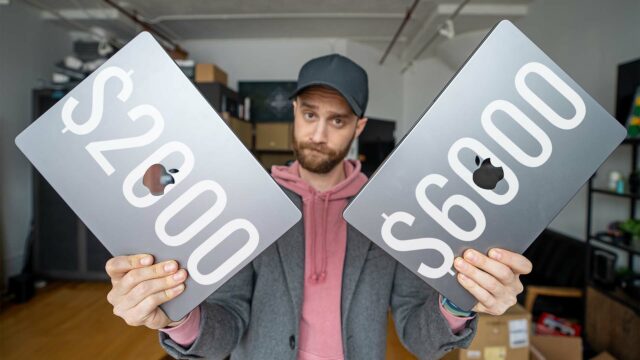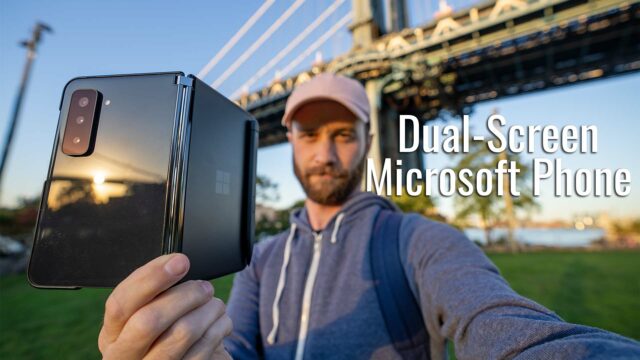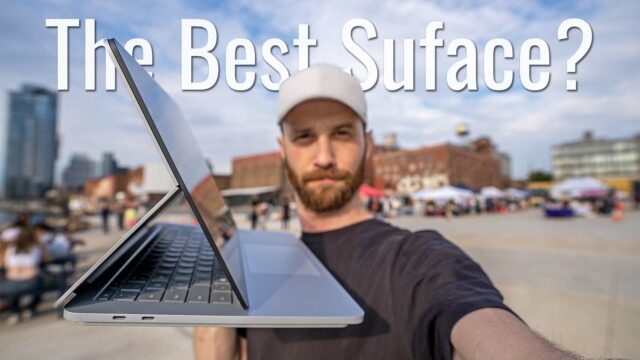Microsoft Surface Book 3 Complete Walkthrough: A Lot More Powerful
It has been over 2 and a half years since the last update to the Surface Book lineup happened and finally after waiting for this long, we now have a new version of Microsoft’s top of the line laptop (or 2-1 one technically).
For now, Microsoft sent me a Surface Book 3 to borrow so let’s go through it in this complete walkthrough.
Now, if you’re not familiar, a complete walkthrough on this channel is where I try and go through every feature I possibly can on a new device so you guys are better prepared should you be in the market to actually go buy one.
With that said, there’s a lot to go through, so let’s get started with the hardware.
Firstly, the Surface Book 3 comes in two sizes: a 13.5” and a 15” model which is what I have here.

They both have the Surface-esque aspect ratio we’ve come to expect of 3:2 (instead of the 16:9 that’s more popular on laptops). I don’t have too much of a preference of either honestly, but 3×2 means you do have a bit more height to work with which can be handy for some tasks.

The 13.5” has a resolution of 3000×2000 while the 15” is 3240×2160 and while Microsoft doesn’t mention a brightness figure on them, I managed to get a reading of about 450 nits on the 15” with a white background at full brightness (so plenty for indoor use and you’ll only struggle a bit if in direct sunlight).

The laptop is made out of magnesium and the 13.5” weight is either 3.38lbs for the i5 model or 3.62 lbs for the i7 model and the 15” here only comes with an i7 option and that weighs 4.2 lbs.
Now, of course we have the sort of claim to fame designwise on the Surface Book still intact and that’s the fact that it can detach its screen from the base via a software icon in the taskbar or the physical button on the keyboard, to become a, massive in a good way I think, tablet.

(And for everyone mentioning the size of the bezels around the screen being larger than what we find on most laptops now, it’s most likely because you need somewhere to hold when using it as a tablet)

You can have Windows even automatically switch to tablet mode when detached–which is something I honestly haven’t used in a long time and find is way more useful than I remember it to be.

The biggest difference in this form factor on the Book vs say the Surface Pro lineup is that it more resembles a proper laptop with a solid base as well as no kickstand. Something to note though is that once you detach it, you do lose the more powerful discrete GPU that is housed in the base that will help with photo editing, etc. and instead you’ll use the internal Intel Iris Plus GPU.

You can remedy this though by actually reattaching the screen backwards and use it at an angle or lay it flat on the keyboard to at least get the tablet feel while keeping the power (as well as the extra battery that that’s housed in the base that we’ll get into a bit more in a sec) even if it makes for a very thick “tablet”.

On the back, we have the unmistakable chrome minimalistic Windows logo and the entire thing falls quite in line with the entire Surface design language, of which I’m a fan of, and if you saw it next to its predecessor, the Surface Book 2, you wouldn’t be able to tell them apart.
Now, one concern some of you mentioned to me was the wobble of the screen that bothered some people on the older models and I can say that it definitely feels secure to me while typing even while on my lap.
Above the screen, we have the same IR hardware and webcam from the Surface Book 2 but Microsoft changed the mics to their newer Studio Mics as they call them. So here’s what that 1080P webcam with the new studio mics looks like and sounds like. I have to admit the mics sound much louder and clearer than before and might be nice for people using it for their more prevalent webcam meetings nowadays.

Below the screen, we have our backlit keyboard that I always loved typing on with the Surface Book 2 and actually feels even better on the Book 3–most likely thanks to the extra bit of key travel we have now.

And beneath that, we have another thing I’ve always loved on Surface Books that is just as good here and that’s the glass precision trackpad. Now, I’ve always harped on how much better precision trackpads are thanks to Windows handling the drivers for them compared to the old way of each OEM doing them themselves. But, when Microsoft does the hardware and handles the software in this case for it, it’s even better, go figure.

Near the top of the screen, we have our four Dolby Atmos speakers.

Moving around the back of the device, we also have a rear facing 8MP camera to be used to take photos of meetings, classes, or documents using the built in camera app for Windows and then you can use the program of your choice to annotate on it with the Surface Pen.

That pen, by the way, is not included with the laptop but–at least at the time of writing this–it’s available for $79 instead of the usual $100. If you do opt for it, it’ll magnetically attach to either side of the laptop screen and does so pretty solidly thankfully.

There is also support for the Surface Dial which has always been intriguing to me as a device you can put on or off the screen and use for various controls in apps that support it, but also costs another $100.
For ports, we have two USB Type-A ports on the left that have been upgraded to USB 3.1 Gen 2 vs the Gen 1 of the last book so they double their theoretical 5gps to 10gpbs. And along with those, we have something I always appreciate on laptops when it can be found as it makes it simpler to offload footage to them, a full SD card reader.

On the right, we have a USB Type-C port that has also been upgraded from 3.1 Gen 1 to Gen 2 but still sadly doesn’t have Thunderbolt 3 which is sad for most creators as that is a connection type that is four times as fast as USB 3.1 Gen 2 and would have allowed to connect to external GPU housings as well as just the plethora of super popular external drives to transfer files faster, but there you go. I honestly make due without any Thunderbolt devices myself so not a big deal to me but definitely is something some of the other YouTubers I know wouldn’t be happy about.

Next to that, we have the sadly proprietary Surface Connect port that you connect the charger to to charge the laptop as well as their also proprietary Surface Dock accessories to (there is another one of these under the screen when you remove it by the way so you could potentially leave the base behind and just bring the charger if you just wanted a tablet).
For connectivity, we have Bluetooth 5.0 and WiFi 6 now (and if curious you can watch my Decodr episode–my explainer series here on the channel for what the benefits of WiFi 6 is here).

As I hinted at earlier we have two batteries in this laptop. Based on running a quick battery report in command prompt, they seem to be a 22.3Wh battery in the display part and a 59.7Wh battery in the base making for a combined 82Wh battery here in the 15” model.

So as is the usual on this channel, let’s do an albeit unscientific test to see how long it lasts playing a YouTube video at 1080P over WiFi at 50% brightness on the default recommended power setting.

And now, because I’m curious, how long does it take to just kill the screen by itself so you can have an idea of how long that’ll last when detached and using it as a tablet.

Something else of note here is the fact that the 15” model now comes with a more powerful 127W charger which is good considering the last model and it’s less powerful charger reportedly had some issues with keeping a charge during heavy gaming with the power settings on “best performance”. That charging brick is also thankfully small and portable and has a little bonus of a 7W USB A port for charging another device with if you want.

Really quick, here’s how long it takes to charge the laptop from 0-100.
Now, let’s talk about what is most exciting about this new Surface Book: what’s on the inside.
We have the option of a 10th gen Intel i5-1035G7 or i7-1065G7 in the 13.5” model and only the option of the latter in the 15” model.
These are paired with much faster than usual 3733mhz LPDDR4X RAM in up to 32GB capacities.
We also have the “fastest SSDs Microsoft has ever shipped” apparently in 256, 512 or 1TB for both models as well as a 2TB option for the 15-inch model.

For GPU, which is something I care about a lot for editing, we have either an Intel Iris Plus or NVIDIA GTX 1650 Max-Q with 4GBs of GDDR5 memory in the 13.5” and we have an NVIDIA GTX 1660 Ti GPU with 6GBs of GDDR6 memory in the 15”.
My hope was that all of that added up to enough power for me to edit my admittedly overkill 6K Blackmagic RAW footage and, well, long story short I have to turn down the resolution on the playback to 1/4th which I do anyway always as there’s no downside to me to do so and it just makes playback smoother and I have to also prerender some things. But it does surprisingly work with my 6K RAW footage in a 4K timeline.
Now, it definitely feels like doing so is pushing the laptop to it’s edge which makes me a little nervous. I’ll keep testing it out more and more to see if those nerves are unwarranted. Also, I noticed that if I drop it down to a 1080P timeline it does it even better. So the footage from my Sony A73 (a probably more appropriate example of what most of you guy might be editing with) should be no problem.
For those interested in gaming with this laptop, here are some of the more popular gaming benchmarks for you to use to compare it to other laptops you’re interested in and see where it sits. Honestly, though this is pretty new mid-tier GPU from NVIDIA so 1080P gaming on here should be pretty solid frankly, you just don’t get ray tracing etc like you do with RTX GPUs.

Speaking of GPUs though, there is a secret model of the Surface Book 3. Well, okay, it’s not secret they mentioned it during the announcement but you can’t find it when buying from the Microsoft site and that’s because they want to only sell it to businesses. There is a model with an NVIDIA RTX Quadro 3000 for $3,499.
For the rest of us, the 13.5” starts at $1,599 while the 15” starts at $2,299 and the unit I tested in this video which is the 32GB 512GB 15” model is $2,799. I’ll leave a link here to the best price I could find as well as for anyone curious about more info.
There you go!













